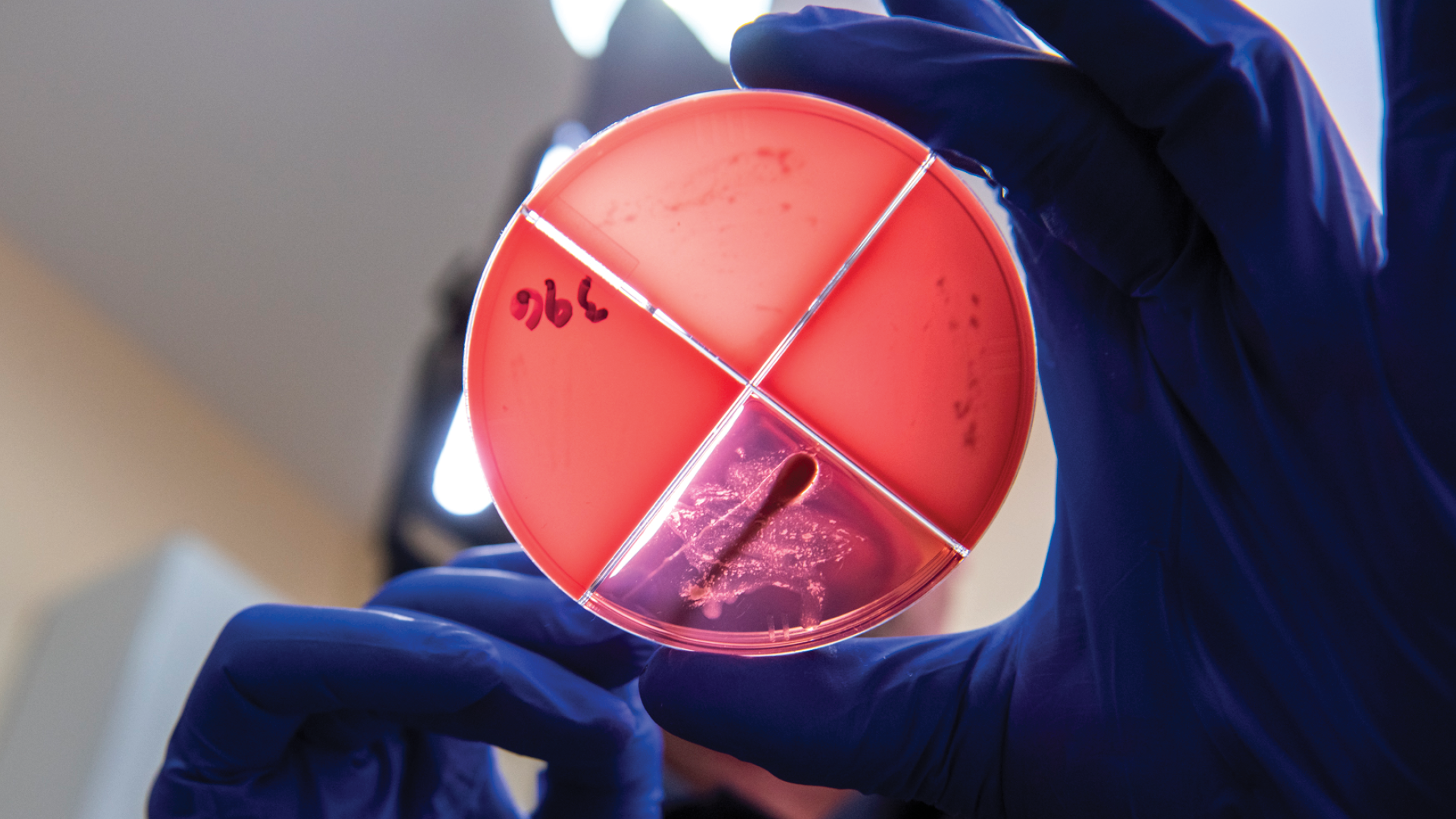Milk culturing matters for mastitis management
By Dr. Tiago Tomazi
Knowing your opponent before choosing weapons for battle can increase your chances of winning the war. Similarly, bacteriological culturing of milk samples can guide mastitis treatment decisions by identifying the bacteria causing intramammary infections (IMI).
Culturing not only provides insights into the causes of clinical mastitis (CM) cases, but also may help you adjust treatment protocols and management. Because not all mastitis-causing bacteria require treatment, culturing supports judicious use of antimicrobials, helps prevent antibiotic resistance and increases food safety.

Culturing milk to establish treatment protocols or adjust management strategies can have direct and indirect impacts on the udder health of a herd. Many options are available, so ask your herd veterinarian to help develop and maintain the best culture program for your operation.
Milk culture laboratory options
Milk culturing can take place on farm or through a private commercial service, veterinary clinic or university lab. On-farm culturing for individual mild to moderate cases of CM can deliver results within 24 hours of sample collection. Outside services are often used to investigate the prevalence of mastitis-causing pathogens or the cause of specific cases and outbreaks that do not necessarily require immediate treatment.
On-farm or veterinary labs typically are most accurate for broad category diagnosis. Selective and/or differential culture media can identify bacterial groups to provide a treat or no-treat decision. Keep in mind that not every type of mastitis-causing bacteria can be identified through this type of testing.
At commercial or university labs, laboratory technicians and microbiologists can provide culture accuracy to the species level including Mycoplasma spp., yeast, Bacillus spp. and Prototheca spp. These labs also may offer more sophisticated technologies, such as MALDI-TOF MS and PCR-based methods to accurately identify bacteria species.
What does bulk tank culturing reveal?
Private or university labs commonly perform microbiologic culture of bulk tank milk samples. These tests are inexpensive and provide broad herd-level information on potential mastitis-causing pathogens, especially organisms transmitted from cow to cow such as Staph. aureus, Strep. agalactiae and Mycoplasma spp.
Although bulk tank cultures can provide insights into an udder health program, use caution when interpreting results, as isolates may arise from individual infected cows or from environmental contamination. Microorganisms such as coliforms, yeasts, non-aureus Staphylococcus and non-agalactiae Streptococcus colonize different reservoirs besides the mammary gland and can be misinterpreted as causes of IMI. For this reason, bulk tank cultures can also help assess hygienic conditions related to milking procedures and milk storage.
When to culture individual cow milk samples?
1. Clinical mastitis cases
Culturing quarters with CM can guide therapeutic interventions for farms implementing pathogen-based programs. This approach also provides information about farm’s pathogen profile, seasonality of causative pathogens and deficiencies in management practices. Pathogen-based programs for the treatment of CM have become more popular over the last decade, especially because not all non-severe CM cases benefit from the antimicrobial use.
Research1 and observational experience over the last decade has shown that on most U.S. farms, as many as one-third of mild and moderate CM cases will not present bacterial growth in the milk culture — often because the cow’s immune defenses eliminated the causative organism prior to sample collection. Another one-third of cases will be caused by Gram-negative bacteria, mainly Escherichia coli, and less frequently, Klebsiella spp. Although we can argue about treatment of Klebsiella CM, most non-severe coliform cases resolve without any therapeutic intervention. Finally, a one-third of cases will be caused by Gram-positive bacteria, which requires the use of antimicrobials to increase the chances of cure and to prevent chronicity.
Considering this scenario, only one in three non-severe CM cases requires therapeutic intervention. Studies evaluating pathogen-based programs for the treatment of CM have reported reductions of antimicrobial use up to 65% without negative effects on cow productivity and udder health parameters.2,3
If you do not have a pathogen-based program for treatment of CM, work with your veterinarian to select a fraction of cases for pathogen identification using a sampling frequency that is low enough to be cost-effective and high enough to be meaningful. For example, freeze a milk sample prior to treatment of the first 20 cases of CM each month and submit them for microbiological identification. This strategy can help you to consistently monitor the causes of CM on the herd and make more assertive decisions regarding control practices to be adopted.
2. Subclinical mastitis cases
Culturing only cows with CM may miss the causes of subclinical mastitis. Use individual cultures to identify cows subclinically infected with contagious pathogens that were previously detected in the culture of the bulk tank. In this case, start culturing cows with high somatic cell counts (>200.000 cells/mL).
Collecting individual samples from non-clinical cows can be performed at the cow or quarter level. Culturing composite samples (milk from two or more quarters in the same vial) can reduce the culturing cost when the results are not used for treatment purposes. On the other hand, culturing samples from each quarter can increase the test sensitivity and is the best option when the results are used to treat quarters with subclinical mastitis. Be aware that except for Strep. agalactiae infections, treating cows with subclinical mastitis during lactation may not be cost-effective. Depending on the causative agent, segregating or culling the cow may be the best alternative.
3. Dry and fresh periods
Intramammary infections acquired during the dry period can have a significant impact on milk production, milk quality, herd removal and reproductive performance post-calving. Culturing cows prior to dry-off is a screening method used to identify cows or quarters to receive antibiotics in a selective dry cow therapy program. Furthermore, culturing cows before drying off and again in the first 10 days post-calving can provide insights into the effectiveness of dry-off therapy.
How do culturing results drive treatment decisions?
Culture results drive informed and effective treatment decisions. Producers should always work with their veterinarian to implement an effective milk culturing program and select the most appropriate and cost-effective treatment protocol to control mastitis on their dairies.
Well-implemented culturing programs enable producers to use more targeted treatments for IMI. When evaluating options for mastitis therapy, minimize production losses by choosing a treatment that rapidly achieves a cure and eliminates the need for re-treatment. Based on the current distribution of mastitis-causing pathogens on dairy farms today, short-duration protocols using narrow-spectrum antibiotics targeting Gram-positive bacteria can provide the most cost-effective treatment of mastitis.
A recent study showed that a two-day protocol with three treatments of AMOXI-MAST® (amoxicillin intramammary infusion) had similar clinical and bacteriological cure of Gram-positive CM as five administrations (once a day) of ceftiofur hydrochloride, a broad-spectrum antimicrobial.3 When comparing the two protocols, cows treated with AMOXI-MAST had their milk back in the tank 3.5 days earlier than the ceftiofur-treated cows, representing extra income for the producer.
Recordkeeping
Tracking and recording the prevalence of mastitis-causing pathogens helps to identify the most cost-effective treatments and determine the best preventative management practices on dairy farms. For a successful mastitis control program, keep thorough records of the culture results, the treatment protocol used in each case and its effectiveness, as well as the length of time the milk was discarded.
Learn more about cattle udder programs from Merck Animal Health at MAHcattle.com.
Important Safety Information
AMOXI-MAST WARNINGS: Milk taken from animals during treatment and for 60 hours (2.5 days) after the last treatment must not be used for food. Treated animals must not be slaughtered for food purposes within 12 days after the last treatment. For complete information, refer to the product label.
References
- Ruegg, P. L. What Is Success? A Narrative Review of Research Evaluating Outcomes of Antibiotics Used for Treatment of Clinical Mastitis. Frontiers in veterinary science 8, 639641-639641, doi:10.3389/fvets.2021.639641 (2021).
- Lago, A., Godden, S. M., Bey, R., Ruegg, P. L. & Leslie, K. The selective treatment of clinical mastitis based on on-farm culture results: II. Effects on lactation performance, including clinical mastitis recurrence, somatic cell count, milk production, and cow survival. J. Dairy Sci. 94, 4457-4467, doi:10.3168/jds.2010-4047 (2011).
- Lago, A., Godden, S. M., Bey, R., Ruegg, P. L. & Leslie, K. The selective treatment of clinical mastitis based on on-farm culture results: I. Effects on antibiotic use, milk withholding time, and short-term clinical and bacteriological outcomes. J. Dairy Sci. 94, 4441-4456, doi:10.3168/jds.2010-4046 (2011).
- Tomazi, T. et al. Negatively controlled, randomized clinical trial comparing different antimicrobial interventions for treatment of clinical mastitis caused by gram-positive pathogens. J. Dairy Sci. 104, 3364-3385, doi:10.3168/jds.2020-18830 (2021).
Find more content for your dairy operation.
About the author

Tiago Tomazi, Ph.D., D.V.M.
Dairy Technical Services, Merck Animal Health
